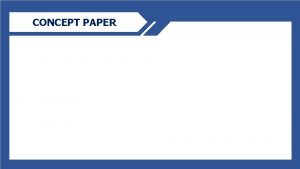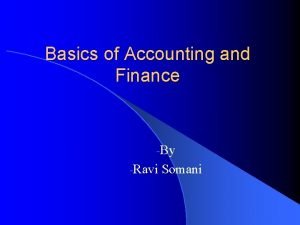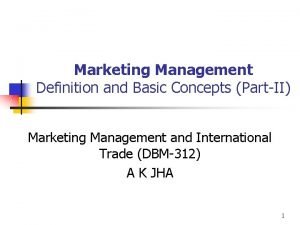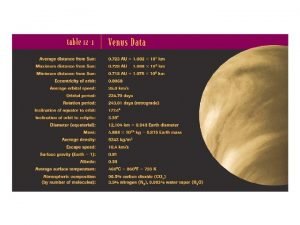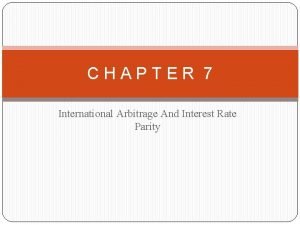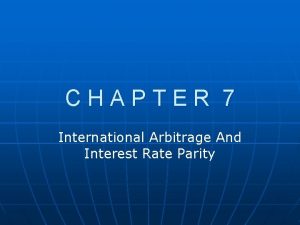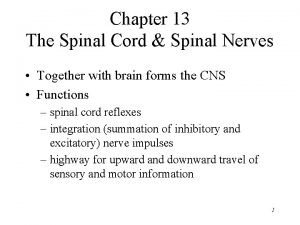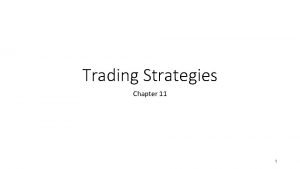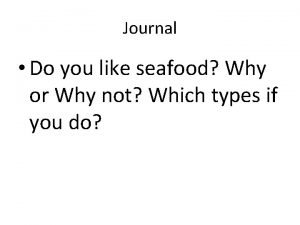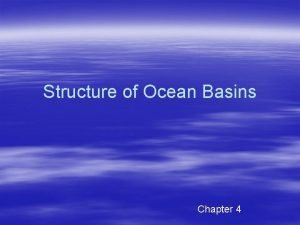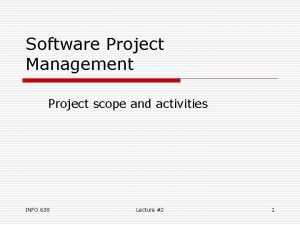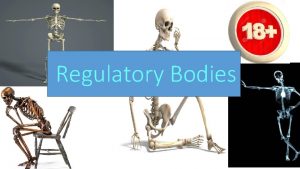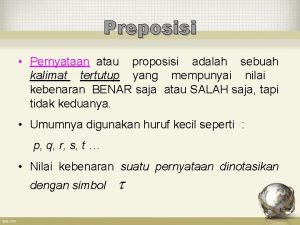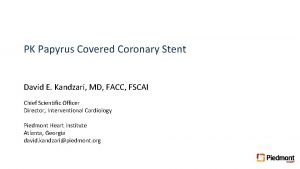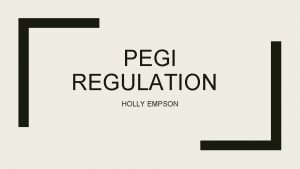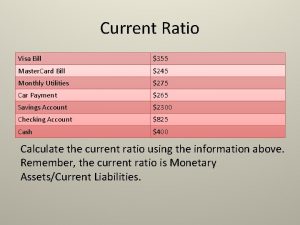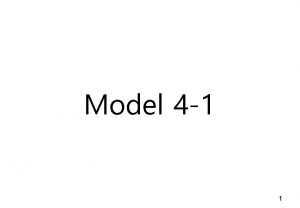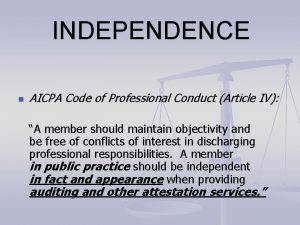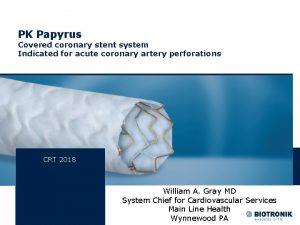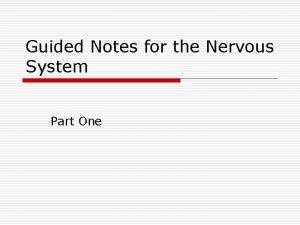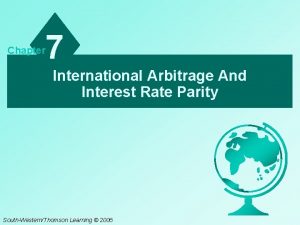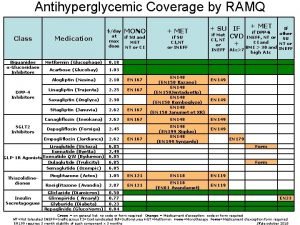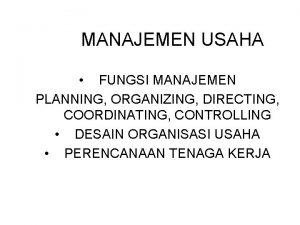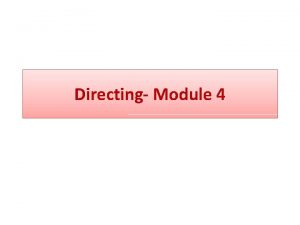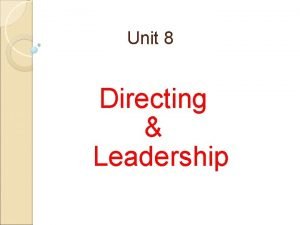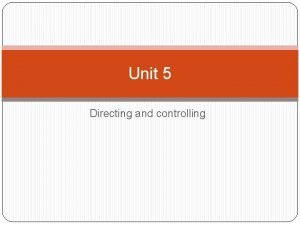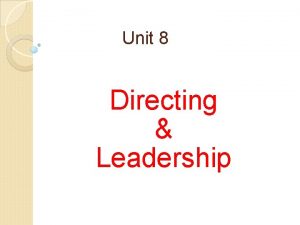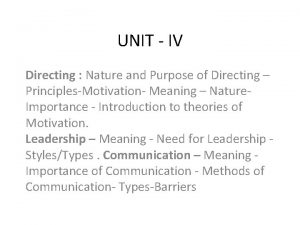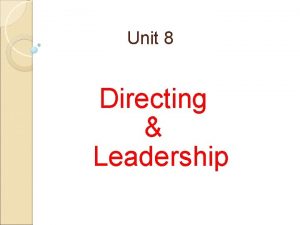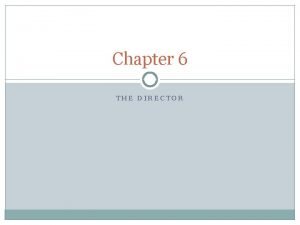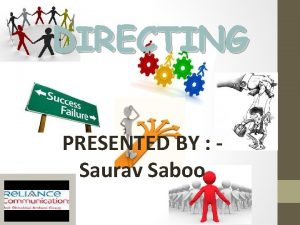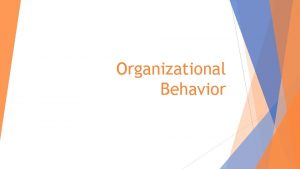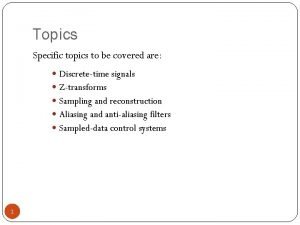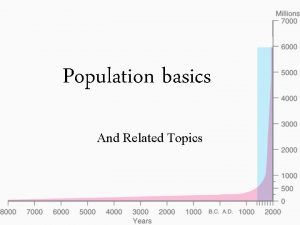UNIT 7 DIRECTING TOPICS COVERED Directing Concept Importance


















































- Slides: 50

UNIT - 7 DIRECTING

TOPICS COVERED Directing Concept Importance Elements of Directing Supervision - Concept and Functions of Supervisor Motivation - Concept, Maslow’s Hierarchy of Needs, Financial and Non Financial Incentives Leadership – Concept and Style Communication - Concept, Formal and Informal communication, Barriers to effective Communication and how to overcome the Barriers

DIRECTING Instructing, Guiding, Communicating and Inspiring people in the Organization Also known “ Management- in- Action”

“Directing is the executive function of guiding and observing subordinates”. - Koontz and O’Donnell

FEATURES OF DIRECTING Initiates Action Takes place at every Level of Management Continuous Process Flows from Top to Bottom

IMPORTANCE OF DIRECTING Initiates Action Integrates Employees Efforts Means of Motivation Facilitates to Implement Changes Creates balance in the Organization

ELEMENTS OF DIRECTING (1) Supervision (3) Leadership (2) Communication (4) Motivational

SUPERVISION Monitor the process of Routine work of one’s subordinates and guiding them properly

CHARACTERISTICS OF SUPERVISION Universal Activity Important part of Directing Function Continuous Process Face to Face Contact Required level of Performance Optimum Utilization Special importance for Lower Level Managers

ROLE OF SUPERVISOR As a Key Man As a Mediato r As a Human Resource Specialist Responsible for putting the Plans of Action of Management into Action Acts as a link between Higher Level Management and the Workers Providing Solutions related to the Problems of Human Behaviour

FUNCTIONS OF A SUPERVISOR Ensure Issuing Instructions Facilitates Control Optimum Utilization of Resources Maintenance of Discipline Feedback Improves Communication Improves Motivation

MOTIVATION It refers to that process which excites people to work for attainment of a desired Objective.

CHARACTERISTICS OF MOTIVATION It is a Internal Feeling Produces Goal Directed Behaviour It can be either Positive or Negative Complex Process

MASLOW’S NEED HIERARCHY THEORY • First time Abraham Maslow categorized the countless needs in five different human needs on the Basis of Priority with following Assumptions: People’s behavior is affected by their needs Needs can be Prioritized After satisfaction of one need, next higher need will serve as motivator People will only move to other need only when lower need is satisfied

PYRAMID REPRESENTING MASLOW’S HIERARCHY OF NEEDS

HIERARCHY OF INDIVIDUAL AND ORGANIZATION RELATED NEEDS Individual Need Hierarchy 5. Self Fulfilment 4. Status 3. Friendship 2. Stability of Income 1. Hunger Organization Need Hierarchy 5. Achievement of Goals 4. Job Title 3. Cordial Relation with Colleagues 2. Pension Plan 1. Basic Salary

INCENTIVES: FINANCIAL It refers to incentives which are in direct monetary form or measurable in monetary terms. Pay and Allowances Productivity linked Wage Incentive Bonus Profit Sharing Co- Partnership Retirement Benefits Perquisites

INCENTIVES: FINANCIAL It refers to incentives which are in direct monetary form or measurable in monetary terms. Pay and Allowances Productivity linked Wage Incentive Bonus Profit Sharing Co- Partnership Retirement Benefits Perquisites

INCENTIVES: NON FINANCIAL It refers to incentives which are not directly related with money. Status Organizational Climate Career Advancement Opportunity Job Enrichment Employee Recognition Programs Job Security Employees Participation Employee Enrichment

LEADERSHIP Influencing others in such a manner to do work what the leader wants them to do.

CHARACTERISTICS OF LEADERSHIP Influencing Process Behaviour changing process Interpersonal Relations between Leader and followers Common Goals Achieving Continuous Process

Basis of Difference 1. Basis of Existence 2. Focus 3. Authority 4. Scope MANAGERSHIP V/S LEADERSHIP Managership Organized Form Attainment of Organizational Objectives Leadership Unorganized Form Satisfaction of Expectations and Aspirations of followers Formal Authority Informal Authority Widespread Limited

IMPORTANCE OF LEADERSHIP Induced by Leadership Expectancy Through Leadership 40 % Normal Expectancy 60 % Social Pressure Need for a Job Authority of Superior Capability Utilization

LEADERSHIP STYLES Leadership style is the manner and approach of providing direction, implementing plans, and motivating people. The three major styles of leadership are Autocratic Leadership Democratic Leadership Laissez Faire Leadership

AUTOCRATIC LEADERSHIP STYLE It refers to that leadership style in which the leader tends to run the show all by himself. I Want Both of You to

CHARACTERISTICS OF AUTOCRATIC LEADERSHIP Centralized Authority Single Man Decisions Wrong Belief regarding Employees Only Downward Communication

AUTOCRATIC LEADERSHIP STYLE advantages of autocratic leadership Disadvantages of autocratic leadership Quick and Clear Decisions Satisfactory work Necessary for Less Educated Employees Lack of Motivation Agitation of Employees Possibility of Partiality Suitability of autocratic leadership When the leader is the most knowledgeable in the group When there is little time for decision making When subordinates are uneducated and unexperienced.

DEMOCRATIC LEADERSHIP STYLE It refers to that leadership style in which the leader consults with his subordinates before making any final decision. Lets work together to solve this …

CHARACTERISTICS OF DEMOCRATIC LEADERSHIP Cooperative Relations Belief in Employees Open Communication

DEMOCRATIC LEADERSHIP STYLE advantages of Democratic leadership Disadvantages of DEMOCRATICleadership High Morale Creation of More Efficiency and Productivity Availability of Sufficient time for Constructive Work Requirement of Educated Subordinates Delay in Decisions Lack of Responsibility in Managers Suitability of DEMOCRATICleadership When group members are skilled. When plenty of time is avilable for decision making When leader wants to involve the subordinates. When roles are clear

LAISSEZ FAIRE LEADERSHIP STYLE It refers to that leadership style in which leader allows the employees to make the decisions. You two take care of the problem while I go. . .

CHARACTERISTICS OF LAISSEZ FAIRE LEADERSHIP Full Faith in Subordinates Independent Decision Making System Decentralization of Authority Self Directed

LAISSEZ FAIRE LEADERSHIP STYLE advantages of Laissez Faire leadership Disadvantages of Laissez Faire leadership Development of Self Confidence in Subordinates High Level Motivation Helpful in Development and Extension of the Enterprise Difficulty in Cooperation Lack of Importance of Managerial Post Suitable only for Highly Educated Employees Suitability of Laissez Faire leadership When followers are highly skilled, educated and experienced Followers are trustworthy

COMMUNICATION Art of transferring of facts, ideas, feelings, etc. from one person to another and making him understand them.

CHARACTERISTICS OF COMMUNICATION Two or More Persons Exchange of Ideas Mutual Understanding Direct and Indirect Communication Continuous Process Use of Words as well as Symbols

TYPES OF COMMUNICATION Formal Communication: Communication within the Officially Sanctioned Boundaries of the Organization Informal Communication: Communication within the Organization which is not officially Sanctioned

TYPES OF COMMUNICATION: FORMAL Characteristics of Formal Communication Written and Oral Formal Relations Prescribed paths Organizational Message Deliberate Efforts

TYPES OF COMMUNICATION: FORMAL Advantages of Formal Communication Maintenance of Authority of the Officers Clear and Effective Communication Orderly flow of Information Easy knowledge of Source of Information

TYPES OF COMMUNICATION: FORMAL Limitations of Formal Communication Overload of Work Distortion of Information Overlooking by the Officers

TYPES OF COMMUNICATION: FORMAL Types of Formal Communication Manager Foreman Worker (Downward Horizontal Communication ) VERTICAL COMMUNICATI ON (Upward Communication )

TYPES OF COMMUNICATION: INFORMAL Characteristics of Informal Communication Formation through Special Relations Two types of Information • About Work • About Individual Uncertain Path Possibility of Rumor and Distortion Quick Relay

TYPES OF COMMUNICATION: INFORMAL Fast Advantages of Informal Communication and Effective Communication Free Environment Better Human Relationships Problems are Easily Solved Social Needs of the Individual is Satisfied

TYPES OF COMMUNICATION: INFORMAL Limitations of Informal Communication Unsystematic Communication Unreliable Information

TYPES OF COMMUNICATION: INFORMAL Types of Informal Communication G B C D H E A A D C A F 4. Cluster x 1. Single Standar d B 2. Gossip Chain 3. Probability

BARRIERS OF COMMUNICATION Semantic Barriers Psychological Barriers Organizational Barriers Personal Barriers

BARRIERS OF COMMUNICATION 1. Semantic Barriers: Badly Expressed messages Symbols or Words with Different Meanings Faulty Translation Un Clarified Assumptions Technical Jargon

BARRIERS OF COMMUNICATION 3. Organizational Barriers: Organizational Policies Rules and Regulations Complexity in Organizational Structure Organizational Facilities

BARRIERS OF COMMUNICATION 4. Personal Barriers: Barriers Related to Supervisors • Fear of Challenge of Authority • Lack of Confidence in Subordinates Barriers Related to Subordinates • Unwillingness to Communicate • Lack of Proper Incentive

COMMUNICATION Measures to overcome the barriers of communication Communicate according to the needs of the Receiver Clarify ideas before Communication Be aware of language, tone and Content Communication for the present as well as future Ensure proper feedback Be a Good Listener

Please be free to write query at: Dr. Ramesh C Sharma rameshchandersharma@gmail. com http: //rameshchandersharma. blogsspot. in +91 -94180 -45154
 What topics will be covered in this unit
What topics will be covered in this unit Concept covered energy flow answer key
Concept covered energy flow answer key Distance per unit
Distance per unit Unit 10, unit 10 review tests, unit 10 general test
Unit 10, unit 10 review tests, unit 10 general test Defining a concept paper
Defining a concept paper Discuss the meaning of educational psychology
Discuss the meaning of educational psychology Importance of accounting period concept
Importance of accounting period concept Components of self-concept slideshare
Components of self-concept slideshare Marketing concept definition
Marketing concept definition Importance of marketing concept
Importance of marketing concept Differentiate ideal self and actual self
Differentiate ideal self and actual self Pengertian marketing concept
Pengertian marketing concept Venus is covered with an atmosphere of dense .
Venus is covered with an atmosphere of dense . Software project management activities
Software project management activities Covered seed
Covered seed Four living creatures covered with eyes
Four living creatures covered with eyes Example of sound devices onomatopoeia
Example of sound devices onomatopoeia Covered interest rate arbitrage
Covered interest rate arbitrage Locational arbitrage
Locational arbitrage External anatomy of spinal cord
External anatomy of spinal cord The life cycle of an angiosperm
The life cycle of an angiosperm Straddle strategy
Straddle strategy Covered call payoff diagram
Covered call payoff diagram Virginia physiographic provinces
Virginia physiographic provinces Do you like seafood
Do you like seafood 6 kingdom classification
6 kingdom classification Which of the following processes involve heat
Which of the following processes involve heat Warships covered with protective iron plates
Warships covered with protective iron plates Broad sediment-covered continental shelves
Broad sediment-covered continental shelves Spm activities
Spm activities Scope of activities example
Scope of activities example Film regulatory bodies
Film regulatory bodies Covered preposition
Covered preposition Pk papyrus covered coronary stent system
Pk papyrus covered coronary stent system Pegi media aspects covered
Pegi media aspects covered What is a dangling participle
What is a dangling participle Month’s living expenses covered ratio
Month’s living expenses covered ratio How much of the earth's surface is covered with water
How much of the earth's surface is covered with water Ocean floor features
Ocean floor features 71 of earth is covered with water
71 of earth is covered with water What are chordates
What are chordates Covered entity
Covered entity Aicpa rule 101
Aicpa rule 101 Echinodermata means
Echinodermata means Papyrus covered stent
Papyrus covered stent Most axons are covered with a fatty material called
Most axons are covered with a fatty material called What is international arbitrage
What is international arbitrage Trulicity ramq
Trulicity ramq Planning organizing staffing directing controlling
Planning organizing staffing directing controlling Planning organizing directing controlling
Planning organizing directing controlling Self-directing teams unleash
Self-directing teams unleash




